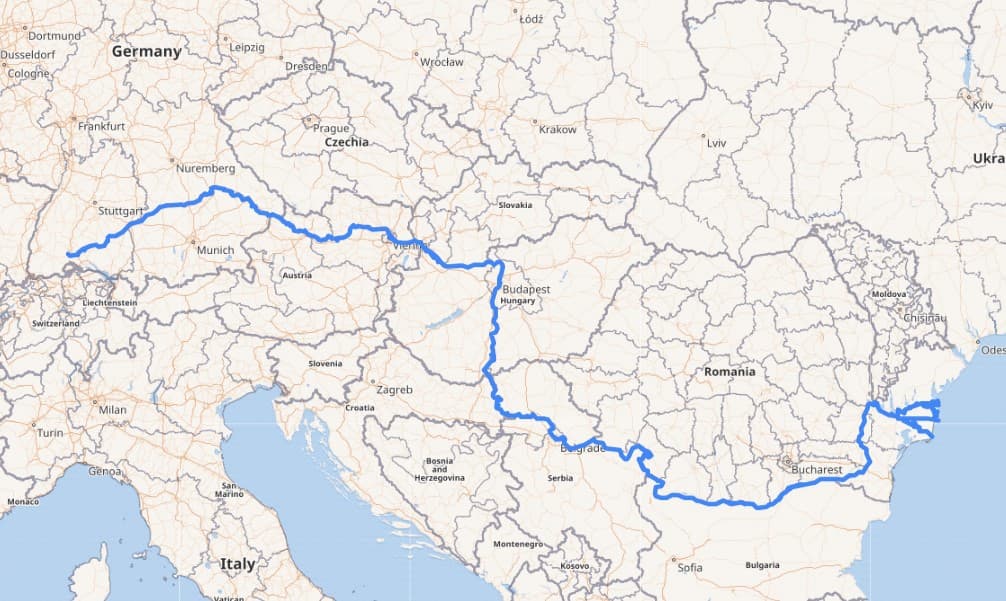Croatian composer Matej Meštrović (b.1969) brought interesting instruments to his 2018 work Danube Rhapsody, adding in the hammer-struck cimbalom and the Croatian long-necked lute, the tambura or tamburitza.

Matej Meštrović
Meštrović uses the folklore of the countries that border the Danube, and the use of particular local instruments locks in that local reference. The Danube flows through 10 different countries, the most of any river in the world, and is the second longest river in Europe, surpassed only by the Volga in Russia.

The Danube River’s path
The work opens with the start of the river in the Black Forest of Germany. A dancing rhythm with a strong melody and gestures opens our riverine explorations. Unlike Smetana’s beginning of The Moldau (Vltava), with its single intertwining sources, the start of the Danube positively gushes out of the ground. A quiet middle section provides a contrast until the river builds up speed again.
Matej Meštrović: Danube Rhapsody – I. Birth of a River (Matej Meštrović, piano; Krajna Marjan, accordion; Svetlana Krajna, tambura; Alan Kanski, cimbalom; Dani Bošnjak, fife; Zagreb Philharmonic Orchestra; Miran Vaupotić, cond.)
The second movement, Danube Dance, moves us into triple time and an um-pa-pa rhythm. A melody in the winds is repeated on the accordion and then the violin. The three instruments intertwine like the dancers they’re supporting. A solo piano section brings out the humorous side of the dancers. It gradually increases speed and adds orchestral instruments until the entire orchestra joins. A decrescendo to slow the dance ends with a cimbalom section as the dance comes to a stop.
Matej Meštrović: Danube Rhapsody – II. Danube Dance (Matej Meštrović, piano; Krajna Marjan, accordion; Svetlana Krajna, tambura; Alan Kanski, cimbalom; Dani Bošnjak, fife; Zagreb Philharmonic Orchestra; Miran Vaupotić, cond.)
The slow movement, Water Reflections, drifts down the river in a pensive mood. A cimbalom melody floats out, melancholic twists in the melody underscored by the slow tempo.
Matej Meštrović: Danube Rhapsody – III. Water Reflections (Matej Meštrović, piano; Krajna Marjan, accordion; Svetlana Krajna, tambura; Alan Kanski, cimbalom; Dani Bošnjak, fife; Zagreb Philharmonic Orchestra; Miran Vaupotić, cond.)
Danubius, the Latin name of the river, brings the solo piano to the fore. The movement resumes the heroic idea of the first movement but now adds a syncopation to the beat.
Matej Meštrović: Danube Rhapsody – IV. Danubius (Matej Meštrović, piano; Krajna Marjan, accordion; Svetlana Krajna, tambura; Alan Kanski, cimbalom; Dani Bošnjak, fife; Zagreb Philharmonic Orchestra; Miran Vaupotić, cond.)
Matej Meštrović’s vision of the mighty Danube gives us peeks into the complex ethnic music that is all part of its travels to the Black Sea. In depicting often private moments in contemplation of the flow of the river, particularly in the third movement, Meštrović is able to bring the river down to our size. The excitement of the beginning of the journey, the visit to a village with dancing, a period of quiet contemplation, and the river’s final exit to the sea are all here, but with enough time to think about the river from source to sea.
For more of the best in classical music, sign up for our E-Newsletter

